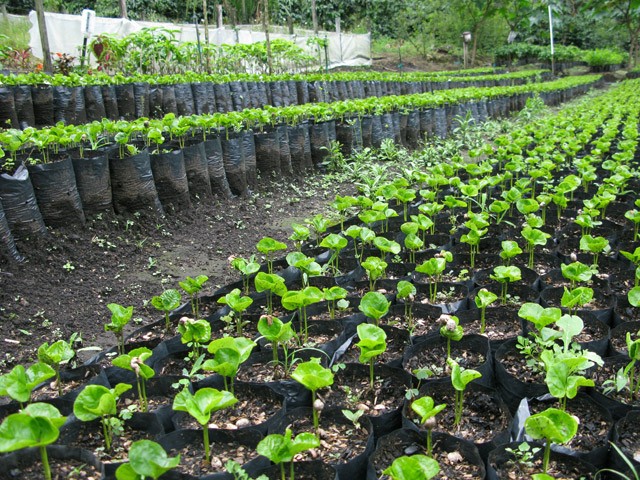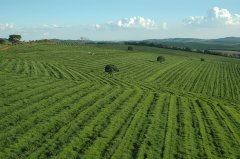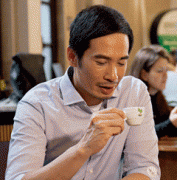Brazilian Coffee beans in Brazilian Sanders Coffee Flavor Italian matching beans the Origin of the Brazilian COE Competition

Professional coffee knowledge exchange more coffee bean information please follow the coffee workshop (Wechat official account cafe_style)
one
Brazilian Santos
When it comes to Brazilian Santos, apart from the football team, I believe many people will think of coffee. Santos is a port in southeastern Brazil. In the past, the name of the port was printed on the export of coffee (generic coffee) from different provinces, but unknown importers promoted Santos as a coffee variety. In fact, similar confusion occurred in the Yemeni port of Mocha.
Brazil is the largest country in Latin America and the world's largest coffee producer in the past 150 years. 1/3 of the world's coffee comes from Brazil, followed by Vietnam, Colombia and Indonesia. The annual production of Minas Gerais province in the south-east alone (20 million bags) has exceeded the national capacity of neighbouring Colombia (about 10 million bags). In addition, Sao Paulo, ESP í rito Santo and Bahia also belong to boutique coffee producing areas. Among them, Sul de Minas (that is, the south of Minas Gerais) has won 90% of the top 20 award-winning coffee of Cup of Excellence (COE) in the past two years.
But behind the brilliant record lies overdevelopment and logging. A tropical rainforest nurtured by the Amazon has been uninhabited for thousands of years. But since the economic incentives of coffee exports in the 18th century, Brazil's primitive ecology has gradually become a mechanized agricultural factory. Legend has it that this history began when an army colonel seduced the wife of the French governor and obtained the seed in 1723. After black slavery and later the European immigrant land distribution system, Brazil's coffee production capacity once reached half of the world's demand. But with the subsequent collapse of commodity markets and "soil fatigue" (as Brazilian farmers say) caused by excessive grain production, farmers have changed their targets from quantity to quantity, coinciding with the rise of the boutique movement in recent years.
two
Strong cocoa flavor Italian formula bean pet
In terms of planting environment, as Brazil has few highlands of more than 3000 feet, coupled with the lack of volcanic soil (Volcanic Soil), it is actually not conducive to growing coffee. The early spread depended on the immediate nutrients provided by the uncultivated red-purple soil (Terra Roxa) and the primeval forests burned to ashes. As a result, Brazilian coffee is not sour, but its strong cocoa and nut flavors, coupled with a mellow taste, make Brazilian coffee the favorite of Italian formula beans. Brazil is also a common basic ingredient (base coffee), whether it is a chain or boutique.
three
Study on bean seeds since the 1930s
Due to congenital conditions, the Brazilian government has invested a lot of resources to improve varieties and disease resistance since the 1930s. Among them, the results of bean research still affect the planting habits of Latin America as a whole. For example, they cultivated the natural variety Yellow Bourbon of Bourbon from 1/1000000 opportunities in the 1930s, discovered Caturra (the Bourbon variety) in the 1940s, and later Mundo Novo (artificial breeding of Typica & Bourbon), Catua í (artificial breeding of Mundo Novo & Caturra), Icatu (with Robusta pedigree) produced in the 1990s, and the rare Acai á (breeding of Mundo Novo). Most of the countries in China and the United States choose suitable varieties from the above list. When my friends encounter problems, they mostly turn to their Brazilian counterparts for advice. The Brazilian Ministry of Agriculture and its academic research institutes established Cons ó rcio Pesquisa Caf é in 1997 to further specialize in coffee planting, disease resistance research and harvesting and treatment. Genoma Caf é, established in 2002, is the forerunner of coffee gene map.
The Cup of Excellence (COE) contest, which represents the boutique sports, is the predecessor of Best of Brazil. Since 1999, 12 countries have participated in the event. In the past, COE only accepted non-tanned coffee, but in view of the fact that Brazilian coffee is mostly tanned and farmers' mastery of the technology has improved, the Congress has held a "Late Harvest" competition for tanned coffee since 2012. In this year's competition, among the top 10 non-tanning groups (Early Harvest), Yellow Bourbon won six and Yellow Catua í three. As for the sun group, Catua í was dominant, accounting for 8. Acai á won the rest of the rankings. It can be seen that the advantages of different kinds of beans will give full play to their potential due to proper handling.
Patrick Tam / tr. by Phil Newell)
Important Notice :
前街咖啡 FrontStreet Coffee has moved to new addredd:
FrontStreet Coffee Address: 315,Donghua East Road,GuangZhou
Tel:020 38364473
- Prev

Brazilian coffee industry Brazilian coffee bean production and processing technology Brazilian coffee export and sales
Professional coffee knowledge exchange more coffee bean information please follow coffee workshop (Wechat official account cafe_style) Brazilian coffee industry Brazil's coffee industry accounts for about 1/3 of the world's total output, is currently the world's largest coffee producer. Coffee plantations in Brazil cover a total area of about 27000 square kilometers, mainly in Minasji in southeastern Brazil.
- Next

Brazilian Coffee Love History: drinking Coffee at the age of three created Brazilian Finch shit Coffee Jacu bird coffee
Professional coffee knowledge exchange more coffee bean information please pay attention to the coffee workshop (Wechat official account cafe_style) Brazil is not only a football kingdom, but also a coffee empire. Once the Brazilian coffee harvest fails that year, it will trigger a sharp rise in global coffee prices. The influence of Brazilian coffee can be more far-reaching than its football. Chen Hao once led the production team to Brazil and filmed it or not.
Related
- Detailed explanation of Jadeite planting Land in Panamanian Jadeite Manor introduction to the grading system of Jadeite competitive bidding, Red bid, Green bid and Rose Summer
- Story of Coffee planting in Brenka region of Costa Rica Stonehenge Manor anaerobic heavy honey treatment of flavor mouth
- What's on the barrel of Blue Mountain Coffee beans?
- Can American coffee also pull flowers? How to use hot American style to pull out a good-looking pattern?
- Can you make a cold extract with coffee beans? What is the right proportion for cold-extracted coffee formula?
- Indonesian PWN Gold Mandrine Coffee Origin Features Flavor How to Chong? Mandolin coffee is American.
- A brief introduction to the flavor characteristics of Brazilian yellow bourbon coffee beans
- What is the effect of different water quality on the flavor of cold-extracted coffee? What kind of water is best for brewing coffee?
- Why do you think of Rose Summer whenever you mention Panamanian coffee?
- Introduction to the characteristics of authentic blue mountain coffee bean producing areas? What is the CIB Coffee Authority in Jamaica?

